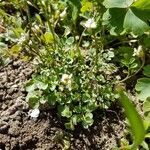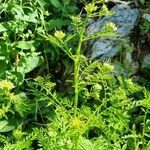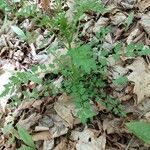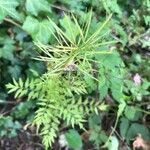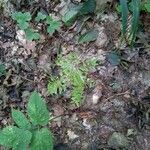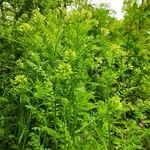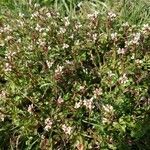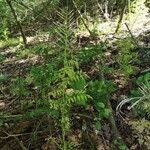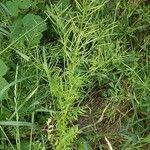Biennials or, rarely, annuals; usually glabrous, rarely sparsely pubescent basally. Rhizomes absent. Stems erect, (angled, sometimes flexuous), unbranched basally, usually branched distally, (1.2-)2-6.5 (-9) dm. Basal leaves (often withered by flowering), rosulate, similar to cauline, with fewer distal leaflets. Cauline leaves 9-24, (9-)13-25-foliolate, petiolate, leaflets petiolulate; petiole 2-6 cm, base auriculate (auricles to 10 × 2.2 mm); lateral leaflets similar to terminal, blade often smaller; terminal leaflet (petiolule to 0.5 cm), blade orbicular, obovate, ovate, or lanceolate, 1-4(-5) cm × 5-17 mm, margins entire or 3-5(-9)-toothed or-lobed. Racemes ebracteate. Fruiting pedicels divaricate or ascending, 3.5-12(-15) mm. Flowers: sepals oblong, 1.2-2(-2.5) × 0.7-1(-1.2) mm, lateral pair not saccate basally; petals (rarely absent), white, oblanceolate, 1.5-4(-5) × 0.6-1.2 mm; filaments 2-3(-4) mm; anthers ovate, 0.3-0.5 mm. Fruits linear, (torulose), (1-)1.6-3(-3.5) cm × 0.9-1.5 mm; (valves glabrous or, rarely, pilose); ovules 10-30 per ovary; style 0.6-1.6(-2) mm. Seeds brown, oblong, 1.1-1.5 × 0.8-1 mm, (compressed, sometimes narrowly winged apically). 2n = 16.
Annual or biennial herbs 15-30 cm high, erect. Basal leaves in a rosette, not persistent, pinnate with 3-5 pairs of broadly ovate, petiolulate leaflets, each with 3-5 rounded lobes; petiole not auriculate. Stem leaves pinnate with 5-9 pairs of ovate-lanceolate to lanceolate, dentate to subentire, petiolulate leaflets; leaflets membranous, ciliolate and occasionally thinly puberulous; petiole with narrow auricles, channelled; auricles and lower part of petiole ciliate. Inflorescence a few-to many-flowered raceme. Flowers small with narrow, white, 2-3 mm long petals only slightly exceeding the sepals. Stamens 4 or 6. Siliquae 1-2.5 cm long, c. 1 mm wide, linear, erect, tipped with a short, thin style; valves smooth. Seeds 1.1-1.4 x 0.8-0.9 mm, flattened, oblong.
A cabbage family herb. It grows 20-65 cm tall. It can be hairy. The leaves vary in size. The leaves are 3-7 cm long. They have lobes. The lobes are oval. The flowers are white and in groups of 20-30 flowers. The flowers are 3-4 mm across. The fruit is a pod. There are many seeds about 1 mm long.
Annual or biennial herb, up to 300 mm tall. Stems erect, leafy. Leaves pinnate; stem-leaves with narrow auricles. Flowers white.
